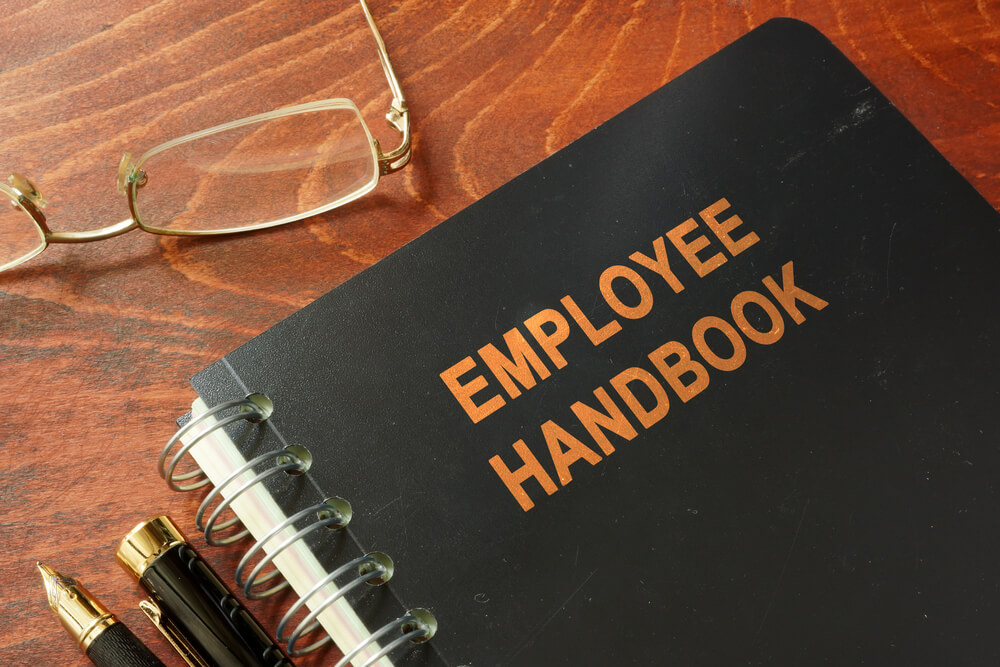The EaseBlog: Employees & Culture

Employee Handbooks: Is Yours Complete?
Employee handbooks form the center point for your company's conduct and policies. A well-structured and thorough employee handbook is a pivotal tool that communicates your company's mission, core values, and expectations beyond its basic task of listing appropriate conduct. However, that is critical, as it ensures legal compliance and protects your business against employee claims.
But is your handbook telling the whole story? Keeping your employee handbook complete, updated, and reflective of your company's culture is arduous, but it's a crucial part of risk management.
In this post, we'll discuss the key components that make an employee handbook complete and how a PEO partner like Easeworks can help you create a tailor-made handbook that fulfills your company needs and maintains compliance.
Understanding Employee Handbooks
An employee handbook is an essential HR solution that guides businesses and keeps them on track by upholding the standard with every incoming employee. Comprehensive employee handbooks act as an ongoing resource, but one of their biggest benefits is helping new employees learn about the company and its scope of responsibilities quickly. An employee handbook provides employees with a clear understanding of the expectations they're held to and what they can expect from the company.
Furthermore, it can act as your first defense if an employee claim arises, stating that your company acted in violation. Many policies exist, each designed to prevent such issues, ensuring your company remains compliant and operational. If these policies and expectations exist in your handbook, they can uphold good conduct and procedures within your daily operations and counter any claims presented against you. That can preemptively prevent a situation where an employee is injured on the job or files a PAGA claim against you while protecting you by demonstrating due diligence.
Critical Components of an Employee Handbook
Company handbooks are only practical if their contents are of high quality. They must cover all essential bases and detail any additional requirements specific to your business.
Some key components you should include in your handbook include the following:
- Company Overview - This is where you share your company's backstory and mission statement. It is the first impression employees get of your company's identity and purpose.
- Code of Conduct - Outlining acceptable professional behavior is crucial. It includes guidelines for conflict resolution and policies against discrimination and harassment.
- Compensation and Benefits - An explicit breakdown of salary structure, bonus schemes, health coverage, and retirement plans can eliminate ambiguity and foster trust.
- Work Hours, Leave, and Vacation Policy - Transparency about work hours, attendance, tardiness, and leave policies set clear expectations immediately.
- Performance Reviews - Providing an overview of the evaluation process, including review frequency and criteria, helps employees understand what is expected of them and how they can grow within the company.
- Promotion and Transfer Policies - Information on the company's approach to promotions and transfers can motivate employees and show them potential career paths. It also helps manage expectations if employees must wait until they are eligible for an increase in compensation while maintaining fairness.
- Disciplinary Procedures - Clearly stating the company's policies on disciplinary actions, up to termination, can deter misconduct and ensure fair treatment.
- Safety and Security - Guidelines for maintaining a safe and secure workplace are critical. This section should include emergency procedures and protocols for reporting safety concerns.
- Equal Opportunity - A commitment to diversity and inclusion, with procedures for reporting discrimination or harassment, sends a powerful message about your company's values.
- Use of Company Property - Policies on using and returning company property help protect company assets and foster responsibility.
- Privacy Policies - This section should outline how the company handles employee data and respects privacy. It helps build trust and reinforces compliance with data protection laws.
- Separation Policies – Procedures for resignations, retirements, and other exits should be clearly defined to ensure a smooth transition for the employee and the company.
A comprehensive handbook can include many more sections, which wholly depend on and evolve with your organization. Regularly updating your handbook helps you keep pace with changes in company policy, regulations, and societal norms. That way, you can adjust to new trends and adapt as your company develops unique needs.
Knowing Your Handbook is Complete
No matter how much you add to your handbook, it's essential to consider what criteria it must meet before you can consider it complete. An employee handbook is an ongoing process that requires regular review and updates, so even if it is complete at any given time, that does change over time. Ensuring it is complete requires closely analyzing its potential for policy gaps, attention to legal updates, and a pulse on the evolving company culture. You can be confident it is properly complete if you appropriately address these factors.
Your handbook must be legally compliant and regularly updated with changing legal trends by addressing regulations on working hours, mandated breaks, and safety conduct. It must also address the company culture to instill the values expected from employees and set their expectations.
Your handbook will grow with your company, providing a firm foundation while being adaptive enough to accommodate shifts in the company's strategic direction.
Get PEO Insight for Your Handbook
Navigating the labyrinth of employment law and HR best practices to shape a comprehensive employee handbook to your company's needs can be challenging and time-consuming, so it's essential to know that you don't need to undertake this task alone. A Professional Employer Organization (PEO) can simplify this complex process.
PEOs are dedicated experts in dealing with the intricacies of workplace policies and procedures. They can use their extensive legal knowledge and experience across multiple industries and businesses. Outsourcing your employee handbook creation to a PEO can help you ensure it is comprehensive, compliant, and up-to-date. They can help you identify policy gaps, keep abreast of legal changes, and ensure your handbook reflects your evolving company culture. It also frees up your internal team's time to focus on your core competencies, secure in the knowledge that your employee handbook is handled by professionals who understand the nuances of HR management.
Blog Categories
- PEO (21)
- Employees & Culture (13)
- Risk Management (8)
- HR Outsourcing (7)
- Human Resources (6)
- Workers' Comp (6)
- Compliance (5)
- Payroll (5)
- PAGA (4)
- Benefits (3)
- Flexible Spending Account (3)
- Podcasts (3)
- Diversity (2)
- HR technology (2)
- Training (2)
- ASO (1)
- Healthcare Savings Account (1)
- Inclusion (1)
- Legal Updates (1)
- PTO (1)
- SB 553 (1)
- Special Districts (1)
- recruiters (1)
- staffing (1)
Subscribe Here!
Let us help streamline the way you manage HR.

Subscribe for our the latest news and legal updates that will affect your business.
Newsletter Sign Up
Contact Us
Get in touch with us today.




